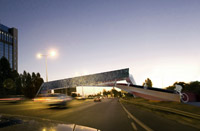When people thought about telephones in underdeveloped countries it was like they would have to invest a huge sum in infrastructure in the form of poles, wires and equipments. No one imagined about cell phones at that time. They transcend most of the infrastructures. In this hour of impending depletion of fossil fuels we have to think differently. The steps may seem small today but they might leave a huge impact in future. Today we can’t be a bystander and watch the energy scene passively.

We know that solar and wind energy is the richest sources of energy. Tiago Barros and Jorge Pereira have created a design that increases the ‘green’ quotient of a bridge. We might have experienced the fact that when cars pass below a bridge, they increase the velocity of the neighboring wind. Tiago Barros and Jorge Pereira are harnessing that quality of the wind. Their designed bridge will light up itself in the night with the power generated by the cars that pass below the bridge by the day. It works on the principle of energy conversion, i.e. from wind to electric energy. The designers believe that cars passing under the bridge will add to wind velocity by up to 20%, optimizing the rotation of the panels. The cross-wind bridge will act like a multipurpose envelope. A unique kind of envelop that will capture the wind power from a network of 2,188 light-weight rotating panels. This bridge is called as Cross-Wind Bridge.
In this design an induction power system plays an important role. It exchanges wind energy through an electromagnetic band located on each panel. This culminates into a power source which is used to light the bridge by night. This clean and green source of energy will increase the green quotient by 35% because of the punctured membrane utilized in the bridge cladding. Why? Because it is made of recycled steel from the auto industry.
Tiago Barros and Jorge Pereira team consists of Ines Valente, Rob Foote III, Yoon-Young Hur, Natalie Bazile and Joao Paulo Fernandes. The cross-wind bridge is 40m in length running southwest / northwest direction over the Segunda circular highway in Lisbon. Its path’s oblique angles are positioned in such a way that they can optimize predominant wind directions. This bridge has another unique feature; it provides a tunnel for pedestrians and bikers too. Cross-Wind Bridge also reconnects and makes accessible the remaining paths of Maria Droste Vila split by the highway and surrounded by Telheiral’s residential park. Again , the bridge gives out an all inclusive message in magnetizing sustainable development and turning rural fragments into areas of public green space.
 Follow
Follow